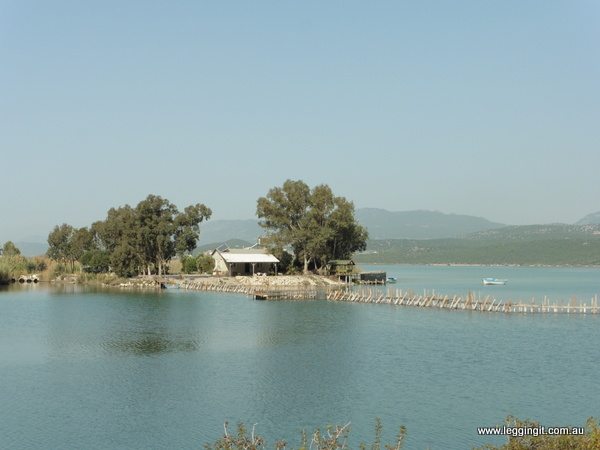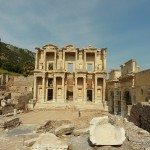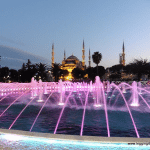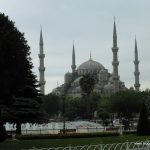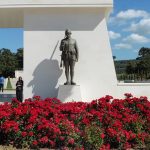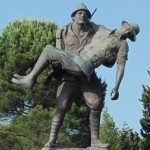Today we planned to ride from Finike to Antalya only about 120 kilometres, but with a few stops along the way. After a simple breakfast at the hotel we jumped on the bike and headed back to Demre, about 30 km’s away from Kinike. Yesterday we briefly rode around the town and passed the ruins of the old Lycian Ruins of Myra. After further research we decided that it was worth returning to Myra as the theatre is quite intact. Also there are many carved artefacts.
The ride along the coast from Finike to Demre was awesome. Perfect sunny weather (maybe just a little too hot for bike gear), great views and lots of twisties.
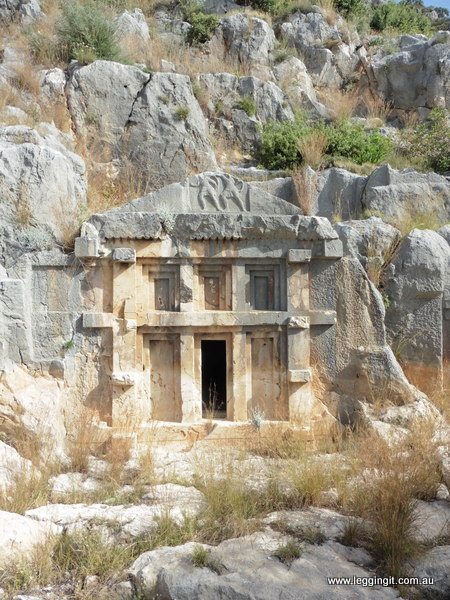
Arriving at Myra we soon discovered that although the site was small it was exquisite. Entry was quite expensive at 20 TL ($10 AUD) and I was spewing that I didn’t have more money in my wallet for I would’ve bought a Museum Card. The Mediterranean Museum Card gives you access to about thirty different museums across the Antalya region.
The ancient Lycian city of Myra dates back over 100 years BC and was a major trading port. It was one of the major Lycian cities along with Xanthos, Pinara, Patara etc. The conversion of pagans to Christianity by St Nicholas in the 4th century AD caused a lot of temples to be destroyed. Muslim raids, earthquakes, flooding, and silting eventually led to the abandonment of the city by the 11th century. Around the theatre excavation has revealed the depth of silting caused by the flooding. Layers of silt and layers of river pebbles almost tell a tale of how often the river flooded. The modern day city of Demre with all its greenhouses sit on top of ancient Myra with only a few buildings still visible.
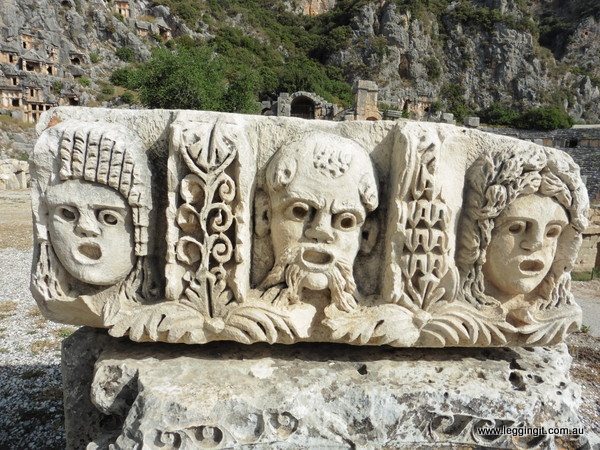
Inside the site at Myra lots of the decorated stones from the theatre are on display. The theatre masks carved on the stone slabs once decorated the walls of the nearby Greco-Roman theatre. There’s also lots of decorated capitals which once topped the gigantic columns of the theatre.
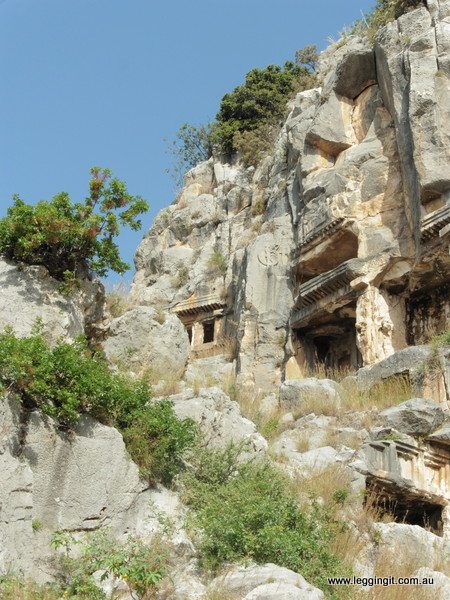
The theatre is set into the base of the hill at Myra alongside Lycian Rock Tombs which stretch up high into the hills. In ancient times the tombs were painted red, yellow and blue which must have been an amazing sight. Although they look fairly simple zooming in on the camera allowed us to see that there were figures carved into the stone. The figures represented a story of the dearly departed’s life.
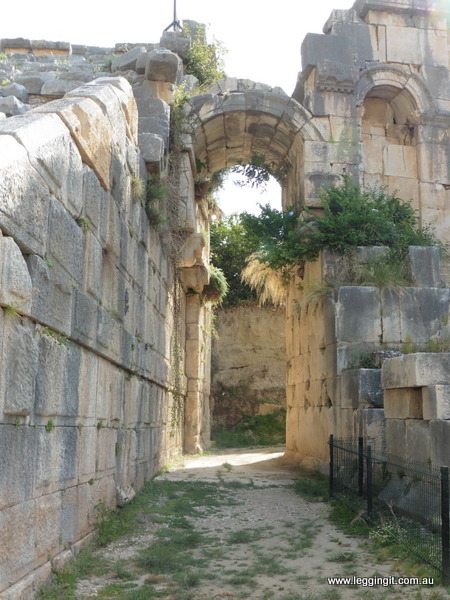
The theatre is quite intact with a decorated front exterior wall and archways which lead to the stage area on either side. A covered staircase leads up to the top of the theatre and could just imagine locals walking the very same steps two thousand years ago.
Along the front of the theatre inscriptions in Greek top the doorways reflecting the Greco-Roman origins and many small rooms lead off giving an idea of the layout. There were stone seats, around the front row of the theatre which would’ve once been reserved for dignitaries which were adorned with carved animals and fish.
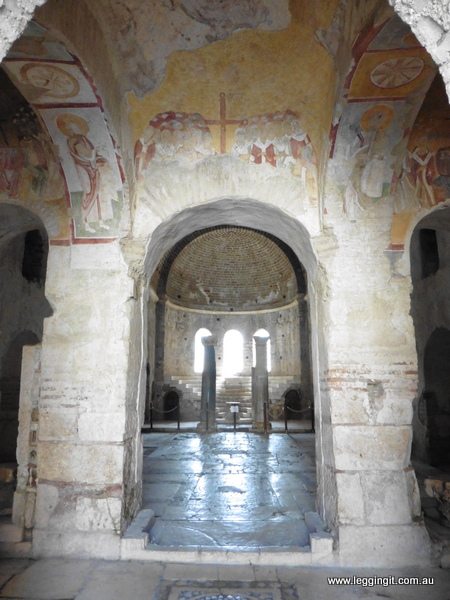
On our way out of Demre we stopped off at the ruins of St Nicholas Church.
Along the way we were able to visit a bank so purchased a Mediterranean Museum Card for just 60 TL . As entry was 20TL we’ve already started making it pay for itself.
St Nicholas was born in the 3rd century into a wealthy family in Patara (another Lycian city we’ve visited). His parents died when he was quite young and instead of using his inheritance he gave it to the sick and needy. He was a devout christian and became the Bishop of Myra. He was exiled and imprisoned during the Christian purges under Roman Emperor Diocletian (whose palace we visited in Split, Croatia). After his release he attended the council of Nicaea (the first ecumenical council) in 325 AD. He died in Myra in 343 and his body was entombed in the church.
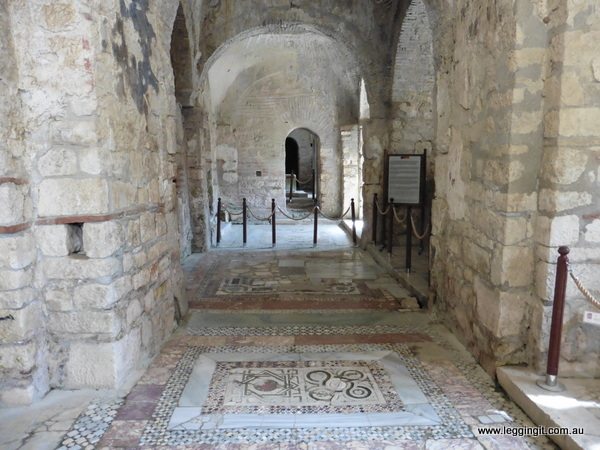
The current church was built in 520, over his original church. In 1087 raiders from Bari in Italy broke into the sarcophagus and removed the body, taking it back to Bari, to be interred in the Basilica Di San Nicola. The Basilica and St Nicholas’ new tomb became a place of pilgrimage and generated a lot of wealth for Bari.
Over time the changing river course flooded the church, filled it with silt, eventually burying it. These days it lies about twenty feet below street level. Russian Tsar Nicholas I, started the restoration of the church in 1862 with some modifications but in the 20th century it was ruined.
Since the establishment of the museum a large roof was added to cover the site of the ruins. A lot of work has been conducted to stabilise the walls and the frescos which adorn the walls and ceilings inside the former church. Walking around inside there are large areas which are tiled with magnificent colours and patterns. The remains of the frescoes which adorn the walls tell the story of St Nicholas’ life. There’s also a sarcophagus with a smashed side which was supposedly St Nicholas’ tomb. Despite being a ruin it still attracts many visitors as around the museum there are many shops selling St Nicholas items. One shop opposite reads St Nicholas ru. so there must be a few Russian pilgrims who visit.
Leaving Demre we headed back to Finike, where we were stopped by police on the edge of town. As soon as we spoke English it must’ve been too hard so he just waved us through. We hurried back to the hotel where, as we’d already packed the bags we just loaded up and headed off. We had a quick detour around Finike in search of the ancient roman bridge which is about 3 km’s from the ruins of Limyra. Supposedly it’s the oldest in existence but as it’s tucked between greenhouses we didn’t find it.
The road from Finike to Antalya passed through large orange and citrus growing areas. It’s a real food bowl area where lots of tomatoes, beans, cucumbers, peppers, eggplants are grown in the thousands of greenhouses which cover the area. Along the way we passed heaps of tractors towing trailers piled high with boxes of produce. The coastal cities of Kumluca and Kemer were quite surprising with all the hothouses surrounding them. They both looked really modern clean cities with wide tree lined avenues and modern five storey apartment blocks.
On the way out of Kemer we were again stopped by the Police, along with a whole heap of vehicles. Currently there’s an increase in security due to Expo 2016 in Antalya. As soon as we started speaking English he thought nope too hard and pointed to an area for us to park. There was a discussion amongst all the policemen and the officer who pulled us over obviously drew the short straw, he sauntered over and simply waved us on.
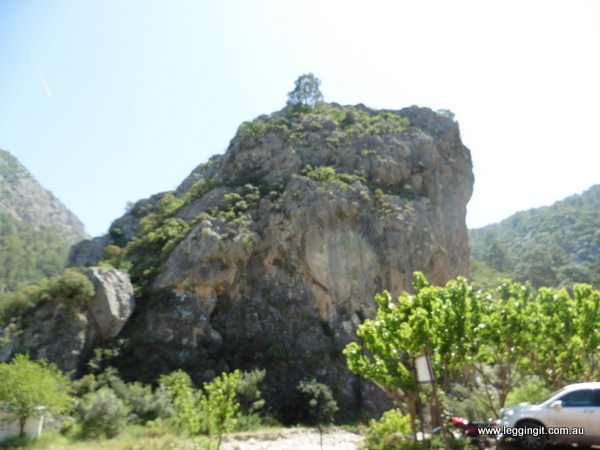
The road wound up through the hills, into quite high mountains with views down into deep valleys. On seeing a sign to Olympos, another Lycian city, we decided to take a look. It was a steep ride down twisting around the ridges as we made our way to the valley floor. As we arrived on the edge of Olympos we discovered that all around it is a tree house village. Well they say tree house but its a bunch of wooden buildings set in the most wonderful location surrounded by trees. It really is a hippies paradise. As soon as we arrived we thought stuff walking in the hot sun let’s sit down in a nice relaxed bar, have drink and bite to eat. Just relax, so we did.
After lunch we just jumped back on the bike and headed towards Antalya.
We saw another historic sign Phaselis, but this time only 1 km off the road, perfect.
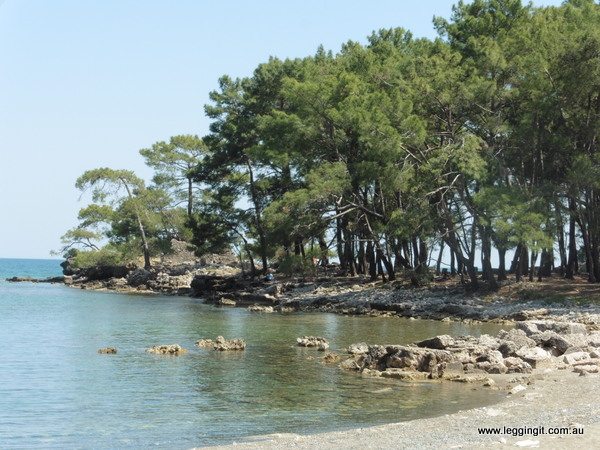
Phaselis dates from 700 BC and was chosen as a city as it has harbours on either side of it. Due to its harbours it became a major port for trade but also a target for pirates. As it was quite vulnerable it was conquered by Persians, Greeks, Romans, Pirates, Egyptians, Rhodians and Arabs. Eventually by the 11th century Arab raids and the opening of more important trading ports saw Phaselis cease to function.
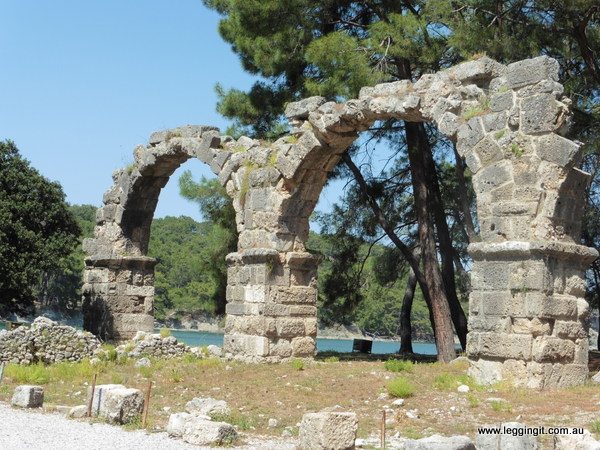
These days the roman ruins from the second century are still visible. There are ruins such as the aqueduct, the theatre, the bath houses, agora, houses and the 24 metre wide streets leading to the ruins of Hadrians gate. Along the streets there are tablets with writing in Greek which extol the virtues of different citizens. The one which had me laughing was one about Augustus whom they stated was “saviour of the universe”. Well I’ll be… I thought Flash Gordon was.
I pointed out the phrase, stating it was a Queen lyric to an English couple. We soon to talking and they told me how they’d backpacked around Australia back in the seventies. We had a great old mag talking about all sorts of things as we took a break from the hot afternoon sun. They told me how they are walking on the final leg of the Lycian Way, a 540 km walk which starts in Ölüdeniz near Fethiye and ends up near Antalya airport. It’s a fair old hike and these pair were no spring chickens. Once again just when you think you’re a real traveller there’s someone to take the wind out of your sails.
After an hour break in Phaselis it was time to make the final run into Antalya.
Riding over the hill we caught our first glimpses of Antalya with all it’s white buildings stretched right around the bay which looked like tombstones. All I could think of was the old bleached white headstones in the graveyard on the cliffs of Sydney.
As we descended into Antalya once again there was a road block and police were checking vehicles. It was a serious checkpoint for just past the first policeman stood his partner with a submachine gun. This time they just waved us through so we didn’t need to stop.
Finding Lara Plaja was harder than expected Michele told me to go straight through Antalya which I took to mean stay on the D400. Well of course by the time we reached the airport turnoff Michele was furious, so we had a shouting match on the side of the road.
After the air had cleared we saw the signs for Lara Plaja so once again set off. Finding the hotel wasn’t as easy as first expected because Lara Plaja is a large strip of beach. We cruised up and down the beach road until an hour later we finally we found it.
We’re staying at the Falcon Hotel in an all inclusive package for four days at $67 a night , where meals and drinks are included It’s a first for us so we’re looking forward to it. After settling into the hotel we headed for the bar. Four days of smorgasbord dining, big breakfasts and free drinks I think we might get used to this.
It was a long day today checking out the different Lycian sites along the way from Finike to Antalya. Tomorrow we’ll check out Antalya’s famous old town.
